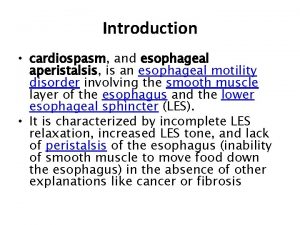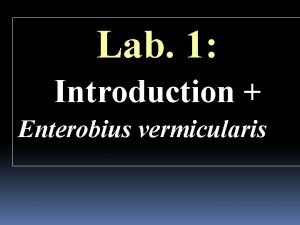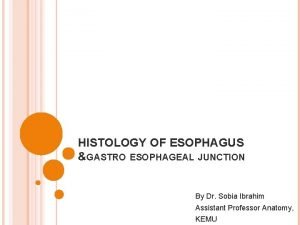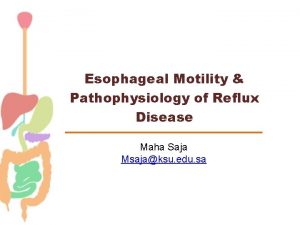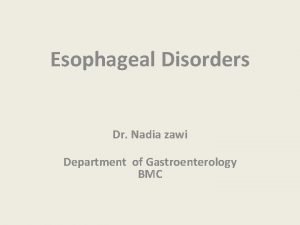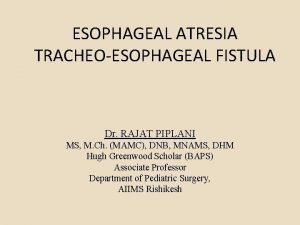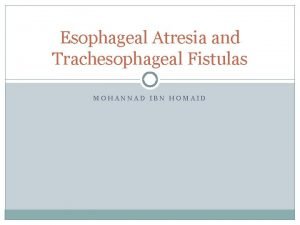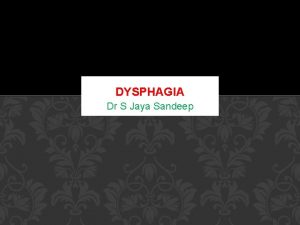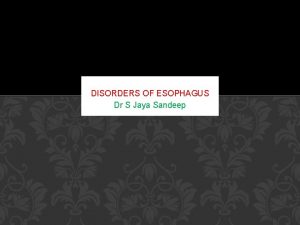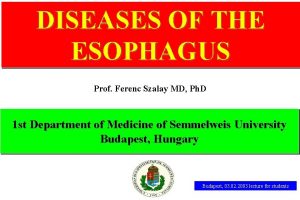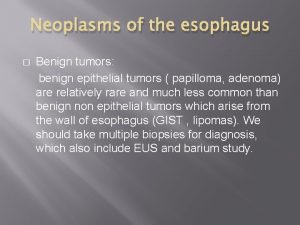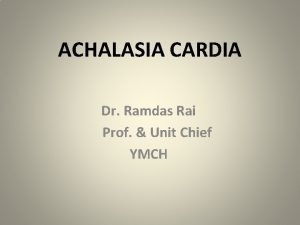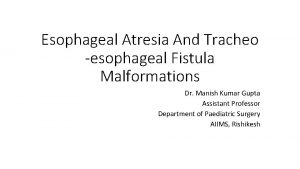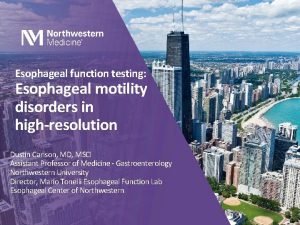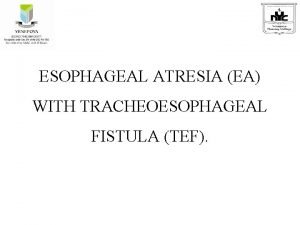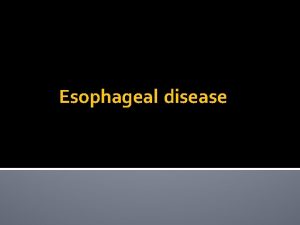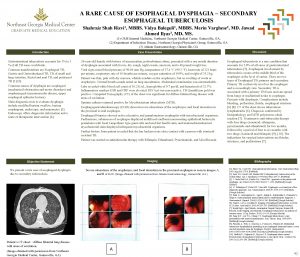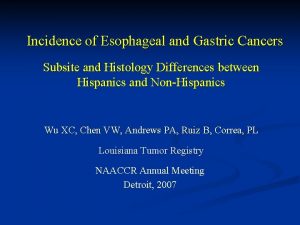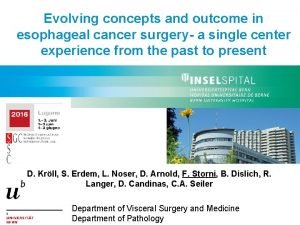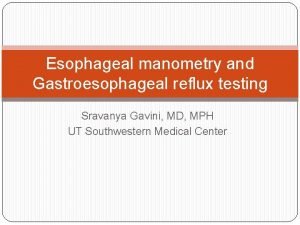Introduction cardiospasm and esophageal aperistalsis is an esophageal
















- Slides: 16

Introduction • cardiospasm, and esophageal aperistalsis, is an esophageal motility disorder involving the smooth muscle layer of the esophagus and the lower esophageal sphincter (LES). • It is characterized by incomplete LES relaxation, increased LES tone, and lack of peristalsis of the esophagus (inability of smooth muscle to move food down the esophagus) in the absence of other explanations like cancer or fibrosis

Definition • Achalasia is characterized by difficulty swallowing, regurgitation, and sometimes chest pain. Diagnosis is reached with esophageal manometry and barium swallow radiographic studies. • Various treatments are available, although none cure the condition. Certain medications or Botox may be used in some cases, but more permanent relief is brought by esophageal dilatation and surgical cleaving of the muscle (Heller myotomy).

Epidemiology • The most common form is primary achalasia, which has no known underlying cause. It is due to the failure of distal esophageal inhibitory neurons. • However, a small proportion occurs secondary to other conditions, such as esophageal cancer or Chagas disease (an infectious disease common in South America). • Achalasia affects about one person in 100, 000 per year. • Prevalence of the condition is 10 in 1, 000 individuals. There is no gender predominance for the occurrence of disease

Signs and symptoms The main symptoms of achalasia are • dysphagia (difficulty in swallowing), • regurgitation of undigested food, • chest pain behind the sternum, and weight loss. • Dysphagia tends to become progressively worse over time and to involve both fluids and solids. Some people may also experience coughing when lying in a horizontal position.

Signs and symptoms • The chest pain experienced, also known as cardio spasm and non-cardiac chest pain can often be mistaken for a heart attack. • It is be extremely painful in some sufferers. Food and liquid, including saliva, are retained in the esophagus and may be inhaled into the lungs (aspiration).

PATHOPHYSIOLOGY • The cause of most cases of achalasia is unknown. • LES pressure and relaxation are regulated by excitatory (e. g. , acetylcholine, substance P) and inhibitory (e. g. , nitric oxide, vasoactive intestinal peptide) neurotransmitters. • Persons with achalasia lack nonadrenergic, noncholinergic, inhibitory ganglion cells, causing an imbalance in excitatory and inhibitory neurotransmission. • The result is a hypertensive nonrelaxed esophageal sphincter.

Diagnosis • An axial CT image showing marked dilatation of the esophagus in a person with achalasia. • Due to the similarity of symptoms, achalasia can be mistaken for more common disorders such as gastroesophageal reflux disease (GERD), hiatus hernia, and even psychosomatic disorders.

Inestigations • Specific tests for achalasia are barium swallow and esophageal manometry. • In addition, endoscopy of the esophagus, stomach and duodenum (esophagogastroduodenoscopy or EGD), with or without endoscopic ultrasound, is typically performed to rule out the possibility of cancer. The internal tissue of the esophagus generally appears normal in endoscopy, although a "pop" may be observed as the scope is passed through the non-relaxing lower esophageal sphincter with some difficulty, and food debris may be found above the LES. •

Treatment • Sublingual nifedipine significantly improves outcomes in 75% of people with mild or moderate disease. • Surgical myotomy provides greater benefit than either botulinum toxin or dilation in those who fail medical management

Medical Treatment • Drugs that reduce LES pressure are useful. These include calcium channel blockers such as nifedipine, [12] and nitrates such as isosorbide dinitrate and nitroglycerin. However, many patients experience unpleasant side effects such as headache and swollen feet, and these drugs often stop helping after several months. • Botulinum toxin (Botox) may be injected into the lower esophageal sphincter to paralyze the muscles holding it shut.

Medical Treatment • As in the case of cosmetic Botox, the effect is only temporary and lasts about 6 months. Botox injections cause scarring in the sphincter which may increase the difficulty of later Heller myotomy. This therapy is only recommended for patients who cannot risk surgery, such as elderly persons in poor health

Pneumatic dilatation • In balloon (pneumatic) dilation or dilatation, the muscle fibers are stretched and slightly torn by forceful inflation of a balloon placed inside the lower esophageal sphincter. • Gastroenterologists who specialize in achalasia have performed many of these forceful balloon dilatations and achieve better results and fewer perforations. • There is always a small risk of a perforation which requires immediate surgical repair.

Pneumatic dilatation • Pneumatic dilatation causes some scarring which may increase the difficulty of Heller myotomy if the surgery is needed later. Gastroesophageal reflux (GERD) occurs after pneumatic dilatation in some patients. • Pneumatic dilatation is most effective on the long term in patients over the age of 40; the benefits tend to be shorter-lived in younger patients. • It may need to be repeated with larger balloons for maximum effectiveness

Surgical Treatment • Heller myotomy helps 90% of achalasia patients. It can usually be performed by a keyhole approach, or laparoscopically. [ • The myotomy is a lengthwise cut along the esophagus, starting above the LES and extending down onto the stomach a little way. • The esophagus is made of several layers, and the myotomy only cuts through the outside muscle layers which are squeezing it shut, leaving the inner muscosal layer intact.

Surgical Treatment • A partial fundoplication or "wrap" is generally added in order to prevent excessive reflux, which can cause serious damage to the esophagus over time. After surgery, patients should keep to a soft diet for several weeks to a month, avoiding foods that can aggravate reflux.

Complications • The complications of achalasia include • weight loss and aspiration pneumonia. • There often is inflammation of the esophagus, called esophagitis, which is caused by the irritating effect of food and fluids that collect in the esophagus for prolonged periods of time.
 Aperistalsis definition
Aperistalsis definition Graham scotch tape method
Graham scotch tape method Acute dysphagia
Acute dysphagia Site:slidetodoc.com
Site:slidetodoc.com Constriction of esophagus
Constriction of esophagus Lower esophageal sphincter is also known as
Lower esophageal sphincter is also known as Nadia zawi
Nadia zawi Dr piplani
Dr piplani Esophageal artesia
Esophageal artesia Esophageal web
Esophageal web Schatzki ring symptoms
Schatzki ring symptoms Esophageal ring
Esophageal ring Esophageal groove in calves
Esophageal groove in calves Zinkers diverticula
Zinkers diverticula Superior mediastinum cross section
Superior mediastinum cross section Esophageal groove in calves
Esophageal groove in calves Triad of achalasia cardia
Triad of achalasia cardia
